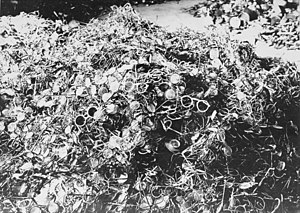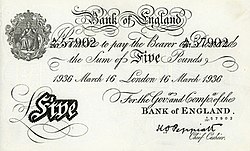Nazi gold (German language: Raubgold, "stolen gold") is the gold transferred by Nazi Germany to overseas banks during World War II. The regime executed a policy of looting the assets of its victims to finance the war, collecting the looted assets in central depositories. The occasional transfer of gold in return for currency took place in collusion with many individual collaborative institutions. The precise identities of those institutions, as well as the exact extent of the transactions, remain unclear.
The present whereabouts of Nazi gold that disappeared into European banking institutions in 1945 has been the subject of several books, , and a civil suit brought in January 2000 against the Vatican Bank, the Franciscan Order, and other defendants.
Acquisition[]

As Minister of Economics, Walther Funk accelerated the pace of rearmament and as Reichsbank president banked for the SS the gold rings of Buchenwald victims

Eyeglasses of Auschwitz victims
The draining of Germany's gold and foreign exchange reserves inhibited the acquisition of materiel, and the Nazi economy, focused on militarisation, could not afford to deplete the means to procure foreign machinery and parts. Nonetheless, towards the end of the 1930s, Germany's foreign reserves were unsustainably low. By 1939, Germany had defaulted upon its foreign loans and most of its trade relied upon command economy barter.[1]
However, this tendency towards autarkic conservation of foreign reserves concealed a trend of expanding official reserves, which occurred through looting assets from annexed Austria, occupied Czechoslovakia, and Nazi-governed Danzig.[2] It is believed that these three sources boosted German official gold reserves by US $71m between 1937 and 1939.[2] To mask the acquisition, the Reichsbank understated its official reserves in 1939 by $40m relative to the Bank of England's estimates.[2]
During the war, Nazi Germany continued the practice on a much larger scale. Germany expropriated some $550m in gold from foreign governments, including $223m from Belgium and $193m from the Netherlands.[2] These figures do not include gold and other instruments stolen from private citizens or companies. The total value of all assets stolen by Nazi Germany remains uncertain.
A growing source of precious metal came from Nazi concentration camps and death camps, where all property was taken from the victims, and included personal effects such as wedding rings, pocket watches, cigarette cases, jewellery and gold teeth. The gold was all collected at the camps and sent to the Reichsbank for melting down for bullion.
Disposal[]
The present whereabouts of the Nazi gold that disappeared into European banking institutions in 1945 has been the subject of several books, , and a civil suit brought in January 2000 in California against the Vatican Bank, the Franciscan Order and other defendants.[3] The suit against the Vatican Bank did not claim that the gold was then in its possession and has since been dismissed.[4][5]
The Swiss National Bank, the largest gold distribution centre in continental Europe before the war, was the logical venue through which Nazi Germany could dispose of its gold.[6] During the war, the SNB received $440m in gold from Nazi sources, of which $316m is estimated to have been looted.[7]
Vatican[]
On October 21, 1946, the U.S. State Department received a Top Secret report from US Treasury Agent Emerson Bigelow.[8][9] The report, released by the U.S. government finally in 1997, established that Bigelow received reliable information on the matter from the American Office of Strategic Services (OSS) or CIC intelligence officials of the US Army.[10] The document, referred to as the "Bigelow Report", was declassified on December 31, 1996, and released in 1997.
The report asserted that in 1945, the Vatican had confiscated 350 million Swiss francs in Nazi gold for "safekeeping," of which 150 million Swiss francs had been impounded by British authorities at the Austro-Swiss border. The report also stated that the balance of the gold was held in one of the Vatican’s numbered Swiss bank accounts. Intelligence reports, which corroborated the Bigelow Report, also suggested that more than 200 million Swiss francs, a sum largely in gold coins, were eventually transferred to Vatican City or to the Institute for Works of Religion (aka the Vatican Bank), with the assistance of Roman Catholic clergy and the Franciscan Order.[11][12][13]
Such claims, however, are denied by the Vatican Bank. "There is no basis in reality to the [Bigelow] report", said Vatican spokesman Joaquin Navarro-Valls, as reported in Time magazine magazine.[14]
Portugal[]
During the war, Portugal, with neutral status, was one of the centres of tungsten production and sold to both Allied and Axis powers. Much of the tungsten was purchased with Nazi gold bullion, which was looted from the countries they had invaded. It is estimated that nearly 100 tons of Nazi gold were laundered through Swiss banks, with only four tons being returned at the end of the war.[15]

A counterfeit £5 (White fiver) note forged by the Jewish Sachsenhausen concentration camp prisoners.
During the war, Portugal was the second largest recipient of Nazi gold, after Switzerland, and this came through the sale of Wolfram with the German armaments industry nearly entirely dependent on the supplies from Portugal.[16] Initially the Nazi trade with Portugal was in hard currency, but in 1941 the central Bank of Portugal established that much of this was counterfeit and Portuguese leader António de Oliveira Salazar demanded all further payments in gold.[17] Presumably the counterfeit currency were the infamous banknotes produced by Sachsenhausen concentration camp victims in Operation Bernhard.
See also[]
- Chiemsee Cauldron
- Gold laundering
- Lake Toplitz
- Moscow gold
- Tripartite Commission for the Restitution of Monetary Gold
- List of missing treasure
- Bank of England
- Montague Norman
- August Frank memorandum
Notes[]
- ↑ Medlicott, William (1978). The Economic Blockade (Revised edition ed.). London: HMSO. pp. 25–36.
- ↑ 2.0 2.1 2.2 2.3 UK Treasury correspondence, T 236/931.
- ↑ Text of the Civil Action of January 21, 2000: Factual Allegations, nos. 25 – 38.
- ↑ United States Court of Appeals for the Ninth Circuit
- ↑ Slovodna Dalmacija
- ↑ Eizenstat Special Briefing on Nazi Gold. Stuart Eizenstat, US State Department, 2 June 1998. Retrieved on 5 July 2006.
- ↑ "Switzerland and Gold Transactions in the Second World War" PDF (1.18 MiB). Bergier Commission, May 1998. Retrieved on 5 July 2006.
- ↑ "CNN:"Vatican drawn into scandal over Nazi-era gold"". July 22, 1997. http://articles.cnn.com/1997-07-23/world/9707_23_swiss.banks_1_swiss-banks-httpwwwdormantaccountsch-dormant-accounts?_s=PM:WORLD.
- ↑ "Inquiry Into Vatican Link to Looted Gold," The Guardian, July 23, 1997, p. 11
- ↑ Aarons, Mark; Loftus, John (1992). Unholy Trinity: How the Vatican's Nazi Networks Betrayed Western Intelligence to the Soviets (revised, 1993 ed.). New York: St.Martin's Press. p. 297. ISBN 0-312-09407-8. http://books.google.com/books?id=HXxew8zc1GQC&pg=RA1-PA297.
- ↑ Paris, Edmond; Perkins, Lois (1961). Genocide in Satellite Croatia 1941-1945: A Record of Racial and Religious Persecutions and Massacres (reissued, 1990 ed.). The American Institute for Balkan Affairs. pp. 306. http://books.google.com/books?id=4IV-HQAACAAJ. ASIN B0007DWXR8
- ↑ Aarons, Mark; Loftus, John (1993). Unholy Trinity: How the Vatican's Nazi Networks Betrayed Western Intelligence to the Soviets (Revised Edition ed.). New York: St.Martin's Press. pp. (432 pages). ISBN 0-312-09407-8. http://books.google.com/books?id=fO9aHgAACAAJ.
- ↑ Manhattan, Avro (1986). The Vatican's Holocaust: The Sensational Account of the Most Horrifying Religious Massacre of the 20th Century (1988, paperback edition ed.). Ozark Books. pp. 237 total. http://books.google.com/books?id=QqDlGAAACAAJ. ASIN B000KOOLWE
- ↑ "The Vatican Pipeline by Frank Pellegrini". Time. Tuesday July 22, 1997. http://www.time.com/time/search/article/0,8599,8505,00.html.
- ↑ Simons, Marlise (10 January 1997). om/1997/01/10/world/nazi-gold-and-portugal-s-murky-role.html "Nazi Gold and Portugal's Murky Role". http://www.nytimes.c om/1997/01/10/world/nazi-gold-and-portugal-s-murky-role.html. Retrieved 1 June 2011.
- ↑ Gonçalves, Eduardo (2 April 2000). "Britain allowed Portugal to keep Nazi gold". http://www.guardian.co.uk/world/2000/apr/02/theobserver1. Retrieved 6 June 2011.
- ↑ Lochery, Neill (17 May 2011). "Portugal's Golden Dilemma". http://online.wsj.com/article/SB10001424052748703509104576326880547925262.html. Retrieved 6 June 2011.
References[]
- Alford, Kenneth D.; Savas, Theodore P. (2002). Nazi Millionaires: The Allied Search for Hidden SS Gold (First Edition ed.). Casemate Publishers and Book Distributors. pp. 319. ISBN 0-9711709-6-7. http://books.google.com/books?id=MjTVPQAACAAJ.
- Wechsberg, Joseph; Wiesenthal, Simon (1967). The Murderers Among Us: The Simon Wiesenthal Memoirs. New York: McGraw-Hill. pp. 335. LCN 67-13204. http://books.google.com/books?id=s030GQAACAAJ. ASIN B000OL6LK8
- Infield, Glenn (1981). The Secrets of the SS (reissued, 1994 ed.). New York: Stein and Day. pp. 288. ISBN 0-515-10246-6. http://books.google.com/books?id=cb5AAAAACAA.
- Aarons, Mark; Loftus, John (1992). Unholy Trinity: How the Vatican's Nazi Networks Betrayed Western Intelligence to the Soviets (revised, 1993 ed.). New York: St.Martin's Press. p. 297. ISBN 0-312-09407-8. http://books.google.com/books?id=fO9aHgAACAAJ.
- Paris, Edmond; Perkins, Lois (1961). Genocide in Satellite Croatia 1941-1945: A Record of Racial and Religious Persecutions and Massacres (reissued, 1990 ed.). The American Institute for Balkan Affairs. pp. 306. http://books.google.com/books?id=4IV-HQAACAAJ. ASIN B0007DWXR8
- Manhattan, Avro (1986). The Vatican's Holocaust: The Sensational Account of the Most Horrifying Religious Massacre of the 20th Century (1988, paperback edition ed.). Ozark Books. pp. 237 total. http://books.google.com/books?id=QqDlGAAACAAJ. ASIN B000KOOLWE
- Sayer, Ian (1984). Nazi Gold: The Story of the World's Greatest Robbery - And Its Aftermath (co-author Douglas Botting with the London Sunday Times). Granada. ISBN 0-246-11767-2. http://books.google.com/books/about/Nazi_Gold.html?id=JD5eOgAACAAJ.
- Yeadon, Glen (2008). The Nazi Hydra in America. Progressive Press. pp. 700. ISBN 0-930852-43-5.
External links[]
- Nazi Gold and Art -- from Hitler's Third Reich and World War II in the News
- Swiss gold holdings and transactions during WW2
- PBS Frontline: Nazi Gold
- Report of the Swiss Bergier Commission
- Nazi Gold Report (Stuart Eizenstat, Under Secretary for Economic, Business, and Agricultural Affairs, on-the-record briefing upon release of U.S. and Allied Wartime and Postwar Relations and Negotiations With Argentina, Portugal, Spain, Sweden, and Turkey on Looted Gold and German External Assets and U.S. Concerns About the Fate of the Wartime Ustasha Treasury, Washington, DC, June 2, 1998)
- (US News and World Report) "A vow of silence. Did gold stolen by Croatian fascists reach the Vatican?" 30n March 1998
- Lawsuit against Vatican Bank to recover Second World War era gold
- Law-Related Resources on Nazi Gold and Other Holocaust Assets, Swiss Banks during World War II, and Dormant Accounts
- Nazi Gold: The Merkers Mine Treasure
- Bank of England role in selling Nazi gold looted from Czechoslovakia
The original article can be found at Nazi gold and the edit history here.